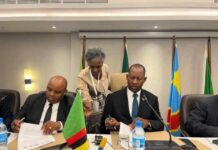Zambia’s economic prospects for the first half of 2013 have remained favourable due to expected good domestic performance driven by the agricultural, manufacturing and construction sectors.
Bank of Zambia (BOZ) Governor Michael Gondwe said gross domestic product (GDP) was expected to be in line with the projected annual GDP growth rate of 7 per cent and recent government initiatives aimed at lowering the cost of borrowing, which were also likely to boost the national output.
Dr. Gondwe said Zambia’s external sector, supported by the continued growth of Non-Traditional Exports (NTEs) and the expected recovery of the global economy, was also projected to improve.
He was speaking in Lusaka last evening at a media cocktail to announce the bank’s actions in contributing to outcomes in the fourth quarter of 2012 and policy focus for the year 2013.
He however highlighted some challenges in the outlook.
Among the challenges highlighted were the fiscal cliff in the United States which is yet to be resolved, spending cuts by some developed economies and a weak consumer and business confidence in most of the developed economies.
The Central Bank Governor added that a fall in copper could also reduce export earnings especially if it was not marched by an increase in export volumes.
Dr. Gondwe further stated that annual consumer price inflation was expected to slow down to 6.4 per cent in June 2013 from 7.3 in December of 2012 despite the inflationary pressures in the first quarter.
He added that any upward risks to inflation would likely emanate from increases in prices of fish following the fish ban and selected vegetables as a result of an unfavourable rain season.
He further explained that this would be moderated by a steady supply of subsidised maize to millers by the Food Reserve Agency (FRA) and also the tightening of the monetary policy recently mainly through the increase in the reserve requirement to eight per cent from five per cent.
Meanwhile, the rebasing currency changeover has been largely successful.
Dr. Gondwe said this was evidenced by the public accepting the currency, adapting to technological systems and implementation of the dual pricing requirement in most environments particularly in the more organized businesses.
Dr. Gondwe said the bank had by the end of January withdrawn a total of K 2, 535 billion of the old currency representing a withdrawal rate of 66 per cent since the introduction of the new currency on 1st January 2013.
He said the bank would continue monitoring the situation on the ground to ensure that any issues arising from the implementation of the rebasing exercise were appropriately addressed.

 JOIN DRIVERN TAXI AS PARTNER DRIVER TODAY!
JOIN DRIVERN TAXI AS PARTNER DRIVER TODAY!











